Indian Journal of Health Social Work
(UGC Care List Journal)
Menu
AN ASSESSMENT OF QUALITY OF LIFE AND PSYCHOLOGICAL
WELLBEING OF YOUNG ADULT STUDENTS WITH DISABILITY AND
WITHOUT DISABILITY
Manglesh Kumar Manglam1 & Ajay Kumar2
1Associate Professor, Department of Psychological Sciences, Central University of South Bihar,
Gaya, India, 2M. A. Psychology, Department of Psychological Sciences, Central University of
South Bihar, Gaya, India
Correspondence: Manglesh Kumar Manglam, e-mail: manglesh@cub.ac.in
ABSTRACT
Background: Disabled students are an integral part of any institution. If disabled students studied
at the university level, their self-confidence, self-esteem, psychological well-being, and quality
of life would develop. Studies related to the quality of life and psychological well-being of disabled
students are still limited in India. Aim: The aim of the present study was to assess the quality of
life and psychological well-being of disabled students and compare them with those of students
who are not disabled. Methods and Materials: The sample consisted of 50 disabled students
and 50 non-disabled students of either sex, aged between 20 and 30 years. Ryff’s psychological
well-being and the WHO quality of life scale were used to assess psychological well-being and
quality of life. Informed consent was obtained from all the participants. The ethics committee at
our university gave its approval to the study. Results: There were significantly lower scores in
disabled students compared to non-disabled students in almost all the domains of quality of life
and all the dimensions of psychological well-being. No significant differences were found between
male and female disabled students on all domains of psychological well-being and quality of life,
except for personal growth dimensions of psychological well-being. Conclusion: Our study
suggests poor quality of life and psychological well-being in disabled students as compared to
non-disabled students.
Keywords: Quality of life, psychological well-being, disabled students, and students without
disabilities.
INTRODUCTION
Higher education can assist people with
disabilities in understanding their rights,
getting respect from others, finding better
jobs, and developing their interpersonal skills
(Nasir & Efendi, 2016; Singal et al., 2015).
The experience of life satisfaction and positive
affect, along with occasional and low levels
of negative affect, has been characterised as
psychological wellbeing (Diener et al., 1997).
According to the World Health Organisation
(WHO), “humans’ perception of their position
in life in relation to their goals, expectations,
standards, and concerns as well as the culture
and value systems in which they live” makes
up quality of life (WHO, 1997).
According to research by Murtaza et al. (2022), pupils who are normal and those who
are impaired have significantly different self
esteem and quality of life. It was also found
that female normal and disabled students had
poor self-esteem and quality of life as
compared to male normal and disabled
students.
People with physical disabilities received the
lowest scores across nearly all dimensions,
whereas people with vision impairments
received the lowest scores in facilities-related
domains. People with speech and hearing
impairments believed they faced greater
discrimination than their peers (Jani et al.,
2022).
Civico et al. (2021) conducted research on a
sample of 182 pupils, 110 of whom were
without impairments and 72 of whom had
disabilities. There was a noteworthy
distinction seen between those with
impairments and those without disabilities for
the overall score and the four-dimensional
psychological wellness measure. The
psychological well-being of students with
disabilities was worse than that of students
without disabilities
Emerson et al. (2020) conducted a study on
the psychological well-being of men and
women with disabilities and found that women
participants had lower psychological
wellbeing than men, especially in the areas
of happiness, value, and life satisfaction.
Cheng and Sin (2020) conducted a study
among university students with hearing
impairment and found that quality of life and
psychological well-being were poor.
Samsari and Soulis (2019) conducted a
comparative study of people with and without
physical disabilities and found that people with
physical disabilities have worse well-being
than people without physical disabilities.
Mpofu et al. (2017) discovered that teenagers
with physical impairments had high levels of
autonomy and choice, purpose in life, healthy
relationships with others, excellent personal
growth, and self-acceptance.
According to Pinquart and Pfeiffer (2011),
people with visual impairments had
significantly worse psychological well-being
than people without disabilities.
Teens with visual impairments showed lower
PWB than their peers in good health, according
to research by Wong et al. (2009).
METHODS AND MATERIALS
Objectives
Objectives
◾️ To assess and compare the psychological
well-being and quality of life of disabled
and non-disabled students.
◾️ To assess the differences in psychological well-being and quality of life between male and female disabled students.
◾️ To assess the differences between psychological well-being and quality of life among visually impaired and orthopaedically handicapped students
◾️ To assess the differences in psychological well-being and quality of life between male and female disabled students.
◾️ To assess the differences between psychological well-being and quality of life among visually impaired and orthopaedically handicapped students
Method
In the current study, 50 disabled students and
the other 50 non-disabled students were
selected through the purposive sampling
method at different institutions in Bihar and
Uttar Pradesh, India. The participants’ age
range was 20 to 30 years for both groups.
Tools
Sociodemographic and clinical data
sheet: A unique sociodemographic and
clinical data sheet was created specifically for
this study in order to gather data on factors
like age, sex, types and percentages of
disabilities, abuse history, any psychiatric
disorders in the family, and history of
substance use.
Ryff’s Psychological Well-Being Scales
(PWB): The 42-item Ryff’s Psychological
Well-Being Scales (PWB) was developed in
1989 by psychologist Carol D. Ryff. The scale
comprises six dimensions and forty-two items. Respondents rate their agreement or
disagreement with 42 items on a 7-point
Likert scale, with 1 being strong agreement
and 7 representing extreme disagreement.
The Psychological Well-Being Scale (Ryff,
1989) has internal consistency reliability
values ranging from 0.86 to 0.93.
World Health Organization Quality of
Life-Brief (WHOQUL-BRIEF): Developed in
1998 by the World Health Organisation. Four
dimensions of quality of life are covered by a
26-item self-report questionnaire: three items
for social interactions, eight for the
environment, six for psychological health, and
seven for physical health. With a Cronbach’s
alpha coefficient of 0.91 for each score item
and 0.67, 0.67, 0.76, and 0.83 for each of its
domains—physical health, psychological,
social relationships, and environmental—the
WHO quality of life was found to be
satisfactorily reliable.
Procedure: The researcher informed the
university’s administration of the study’s
goals. After receiving con sent from the
students and the university’s administration,
the researcher administered the WHO quality
of life scale and the psychological well-being
scale. The ethics committee at our university
gave its approval to the study.
Statistical analysis: For data analysis, SPSS
20 (IBM) for Windows was utilised. Number
and percentage were used in descriptive
statistics for discrete or categorical data,
whereas mean and standard deviation were
used for continuous variables. An independent
sample t-test was used to compare the
continuous variables. The level of significance
was kept at the p<0.05 level.
RESULTS
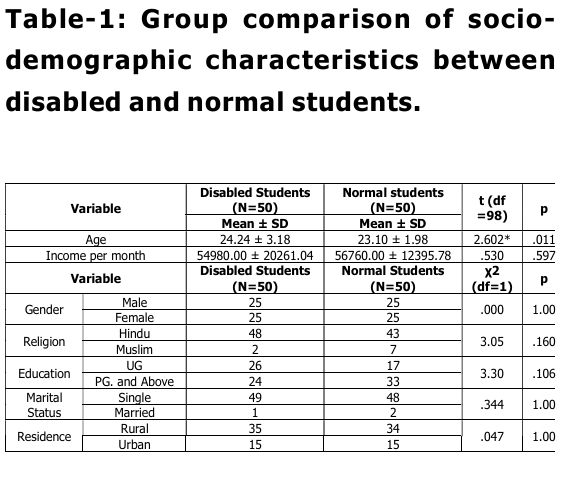
Table-1: shows the socio-demographic
characteristics of disabled students and
normal students. Age was significantly higher
in disabled students than in normal students
(t = 2.602, p = <.05). There were no
significant differences found between disabled
students and normal students in religion,
education, marital status, and residence.
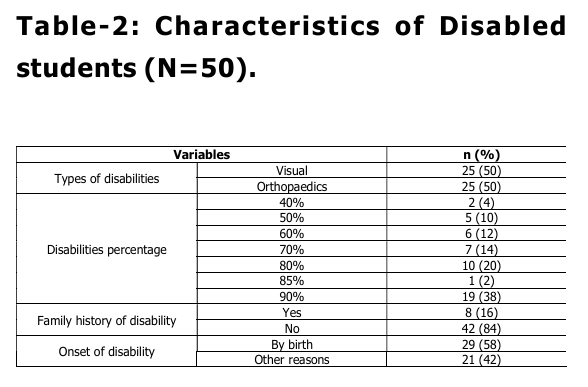
Table-2: displays the characteristics of
disabled students. Fifty percent of the students
were visually impaired, and 50% were
orthopaedically handicapped. Out of 50
students, 2 students had 40% disability, 5
students had 50% disability, 6 students had
60% disability, 7 students had 70% disability,
10 students had 80% disability, 1 student had
85% disability, and 19 students had 90%
disability. Sixteen percent of the students had a family history of disability. 58% of the
students had disabilities by birth, and 42% of
the students had disabilities for other reasons.
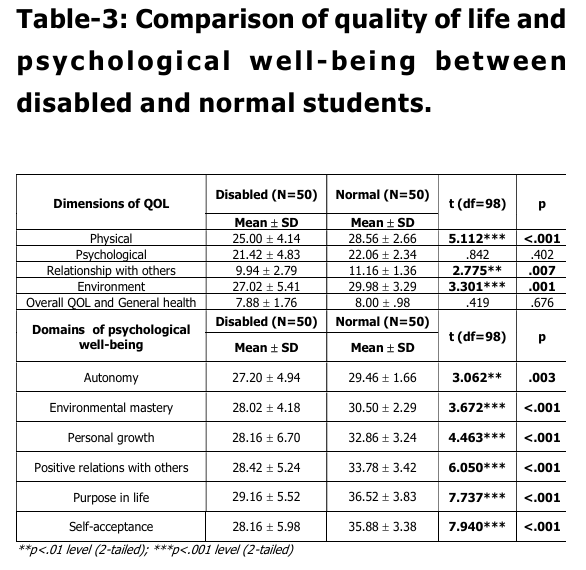
Table-3: shows a comparison of quality of
life and psychological well-being between
disabled and normal students. There was a
significant lower score in physical domains (t
= 3.062, p = <.01), environmental mastery
(3.672, p = <.001), personal growth (4.463,
p = <.001), positive relations with others (t
= 6.050, p = <.001), purpose in life (t = 7.737,
p = <.001), and self-acceptance (7.940, p =
<.001) in disabled students as compared to
normal students.
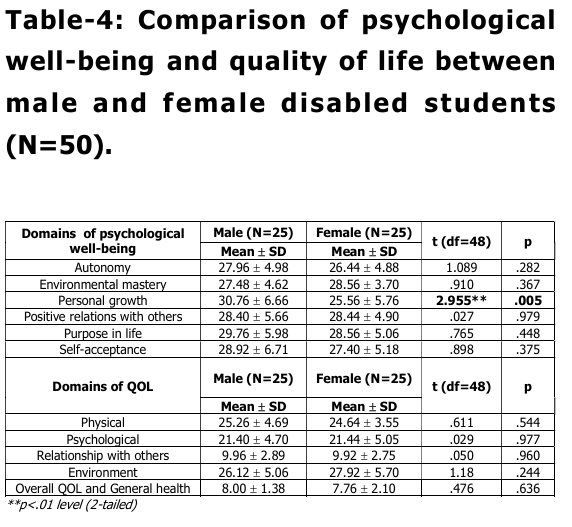
Table-4: shows a comparison of
psychological well-being and quality of life
between male and female disabled students.
Female students had a significantly lower
score in personal growth (t = 2.995, p =
<.01) as compared to male students. There
were no significant differences found
between male and female students in any
other dimensions of psychological well-being.
When the quality of life was compared
between male and female disabled students,
it was found that there was no significant
difference in any dimensions of quality of life
between male and female disabled students.
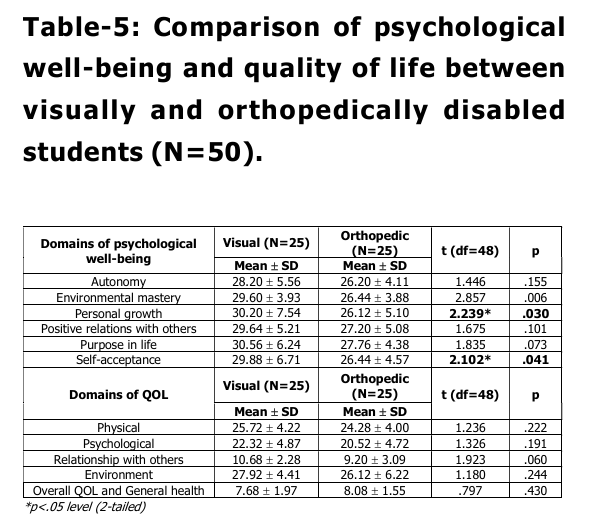
Table-5: Shows the comparison of
psychological well-being and quality of life
between visually and orthopaedically
handicapped students. There was a
significantly lower score in personal growth
(t = 2.239, p = <.05) and self-acceptance
dimensions of psychological well-being (t =
2.102, p = <.05) in orthopaedically
handicapped students as compared to visually
impaired students. There were no significant
differences found between visually and
orthopaedically handicapped students in any
other dimensions of quality of life. When
quality of life was compared between visually
impaired and orthopaedically handicapped
students, it was found that there was no significant difference in any dimensions of
quality of life between visually impaired and
orthopaedically handicapped students.
DISCUSSION
The aim of the present study was to examine
the psychological well-being and quality of life
of disabled students and compare them with
those of normal students. The group of
disabled students had an average age of
24.24 years with a standard deviation of 3.18
years, and normal students had an average
age of 23.10 years with a standard deviation
of 1.98 years. This study’s findings are
consistent with other research conducted by
Jani et al. (2022), Cheng, and Sin (2020).
When comparing the quality of life and
psychological well-being, it was found that
disabled students had poor quality of life in
all domains of quality of life (i.e., physical,
psychological, relationships with others, and
environment) except overall quality of life and
general health as compared to normal
students. Almost similar findings were
reported by Murtaza et al. (2022). They found
that disabled students had a poor quality of
life as compared to normal students.
In this study, it was found that disabled
students had poor psychological well-being in
all the dimensions of the psychological well
being scale (i.e., autonomy, environmental
mastery, personal growth, positive relations
with others, purpose in life, and self
acceptance) as compared to normal students.
Murtaza et al. (2022) found almost similar
findings. Civico et al. (2021); Samsari and
Soulis (2019) conducted research on disabled
students and non-disabled students and found
that the psychological well-being of students
with disabilities was worse than that of
students without disabilities. Mpofu et al.
(2017) found that students with physical
disabilities had a high level of psychological
well-being.
When comparing the psychological well-being
and quality of life among male and female
disabled students, Findings of the present
study indicated that there was no significant
difference between male and female disabled
students on all the dimensions of psychological
well-being except personal growth. Findings
showed that male students had higher
personal growth as compared to female
disabled students. Emerson et al. (2020) did
research and found that female students with
disabilities had poor psychological well-being
as compared to male students. Findings of the
current research revealed that there was no
significant difference in all domains of quality
of life among male and female disabled
students. This showed that male and female
disabled students had a similar quality of life.
This finding was not supported by previous
research done by Murtaza et al. (2022). They
found that female disabled students had a
poor quality of life.
In the current study, visually impaired
students had higher scores on personal
growth and self-acceptance as compared to
orthopaedically handicapped students. This
demonstrated that visually impaired students
were more receptive to new experiences, felt
more like they were living up to their potential,
could see their own progress, and were able
t o recognise and value their own
accomplishments. They were also able to feel
good about themselves despite being aware
of their own limitations, accept both their
positive and negative traits, and place a high
value on their past.
CONCLUSION
Findings of the current study indicated that
students with disability had poor quality of life
and psychological well-being as compared to
normal students. No significant difference was
found between male and female students on
psychological well-being and quality of life.
Visually impaired students had higher score
on personal growth and self-acceptance as compared to orthopaedically handicapped
student. Two main drawbacks of the study
were the cross-sectional research design and
the small sample size. This research suggests
t hat providing qualified experts with
counselling services is necessary to improve
the psychological health and quality of life for
students with disabilities.
REFERENCES
Cheng, S., & Sin, K. F. (2020). University self
efficacy and quality of university life
among students with and without
hearing impairment and hearing
students. International Journal of
Disability, Development and Education,
1-13. https://doi.org/10.1080/
1034912X.2020.1801989.
Civico, F. J. A., Acedo, V. L., Herves, M. A. M.,
& Osella, E. M. M. (2021).
Psychological well-being and disability:
a comparison among university
students. Electronic Journal of
Research in Educational Psychology,
19(1), 93-116.
Diener, E., Suh, E., & Oishi, S. (1997). Recent
findings on subjective well-being.
Indian Journal of Clinical Psychology,
24(1), 25–41.
Emerson, E., Fortune, N., Aitken, Z., Hatton,
C., Stancliffe, R., & Llewellyn, G.
(2020). The wellbeing of working-age
adults with and without disability in
the UK: Associations with age, gender,
ethnicity, partnership status,
educational attainment and
employment status. Disability and
Health Journal, 13(3), 100889. https:/
/doi.org/10.1016/j.dhjo.2020.100889
Jani, R., Alias, A. A., & Tumin, M. (2022).
Persons with disabilities’ education
and quality of life: evidence from
Malaysia. International Journal of
Inclusive Education, 26(8), 753–765.
h t t p s : / / d o i . o r g / 1 0 . 1 0 80 /
13603116.2020.1726511
Mpofu, J., Sefotho, M. M., & Maree, J. G.
(2017). Psychological well-being of
adolescents with physical disabilities
in Zimbabwean inclusive community
settings: An exploratory study. African
Journal of Disability 6(0), a325. https:/
/doi.org/ 10.4102/ajod.v6i0.325
Murtaza, H., Kausar, N., & Mazhar, M. (2022).
Self-esteem and quality of life among
students with and without physical
disability, Pakistan Journal of Social
Research PJSR, 4(3), 267-273. DOI:
h t t p s :/ / doi. o rg/10.52567/
pjsr.v4i03.711.
Nasir, M. N. A., & Efendi. A. N. A. E. (2016).
Special education for children with
disabilities in Malaysia: progress and
obstacles. Geografia Online TM
Malaysian Journal of Society and
Space, 12 (10), 78–87.
Pinquart, M., & Pfeiffer, J. P. (2011).
Psychological well-being in visually
impaired and unimpaired individuals:
a meta-analysis. British Journal of
Visual Impairment, 29(1), 27-45.
h t t p s : / / d o i . o r g /
10.1177%2F0264619610389572.
Ryff, C. D. (1989). Happiness is everything,
or is it? Explorations on the meaning
of psychological well-being. Journal of
Personality and Social Psychology,
57(6), 1069-1081. https://doi.org/
10.1037/0022-3514.57.6.1069
Samsari, E. P., & Soulis, S. G. (2019). Problem
solving and resilience self-efficacy as
factors of subjective well- being in
Greek individuals with and without
physical disabilities. International
Journal of Special Education, 33(4),
938-953.
Singal, S., Mahama, S. E., Iddrisu, K., Casely
Hayford, L., & Lundebye, H. (2015).
The impact of education in shaping
lives: Reflections of Young People with Disabilities in Ghana. International
Journal of Inclusive Education Volume
19(9), 908-925. DOI: 10.1080/
13603116.2015.1018343
WHO, (1997). Measuring quality of life. The
world health organization quality of
life instruments. Geneva, WHO, 1997.
WHOQOL Group (1998). Development of the
World Health Organization WHOQOL
Brief quality of life assessment.
Psychological Medicine, 28, 551-558.
DOI: https://doi.org/10.1017/
S0033291798006667.
Wong, H. B., Machin, D., Tan, S. B., Wong, T.
Y., & Saw, S. M. (2009). Visual
impairment and its impact on health
related quality of life in adolescents.
American Journal of Ophthalmology,
147(3), 505–511.e1. https://doi.org/
10.1016/j.ajo.2008.09.025
Conflict of interest: None
Role of funding source: None


